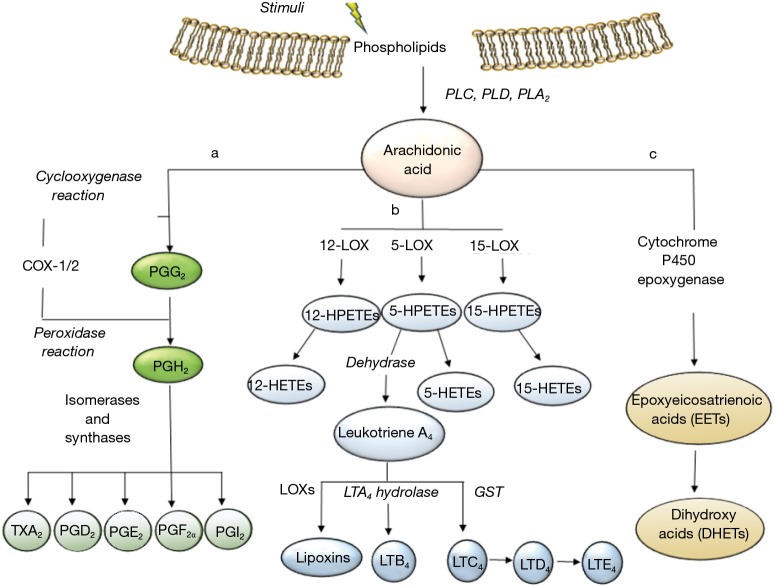Figure 2.
Arachidonate metabolism pathways. Several stimuli, such as thrombin, histamine and platelet-derived growth factor (PDGF), can induce the transformation of membrane phospholipids into arachidonic acid (AA), through three different phospholipases: phospholipase A2 (PLA2) phospholipase C (PLC) and phospholipase D (PLD). AA is oxygenated and transformed into several products which mediate or modulate different biological responses by three different major pathways: the cyclooxygenase (COX), the lipoxygenase (LOX) and the cytochrome P450 epoxygenase (CYP-P450) pathways. (a) AA can be transformed to prostaglandin G2 (PGG2) by the cyclooxygenase reaction and, then, to prostaglandin H2 (PGH2) by the peroxidase reaction. PGH2 is metabolized in prostaglandins (PGD2, PGE2, PGF2α), prostacyclin (PGI2) and thromboxane A2 (TXA2) by different isomerases or synthases; (b) the second major pathway of AA metabolism involved a class of enzymes called lipoxygenase (12-, 5-, and 15-LOX) which transform the arachidonate to hydroperoxides (12-, 5- and 15-HPETE). The hydroperoxides are converted by the peroxidases into hydroxyeicosatetraenoic acid (12-, 5- and 15-HETE). The 5-HETE can be dehydrated, by the dehydrase enzyme, into the unstable epoxide intermediate leukotriene A4 (LTA4) which can be hydrolyzed to form dihydroxy-derivative (LTB4) or can be linked with glutathione to produce LTC4. This leukotriene is transformed to LTE4 by glutamyl transferase and aminopeptidase actions while LTA4 can also function as a precursor of the lipoxins; (c) cytochrome(CYP) P450 epoxygenases convert AA to epoxyeicosatrienoic acids (EETs). The EETs are short-lived, being rapidly converted to less active or inactive dihydroxy-eicosatrienoic acids (DHETs).

